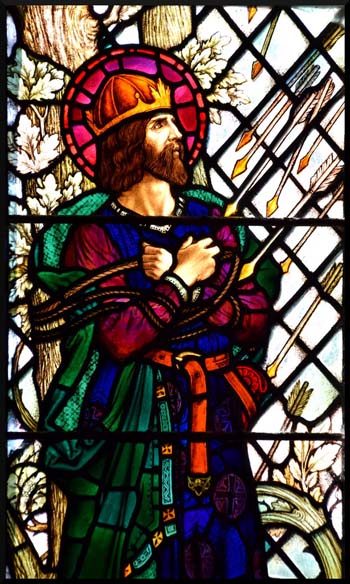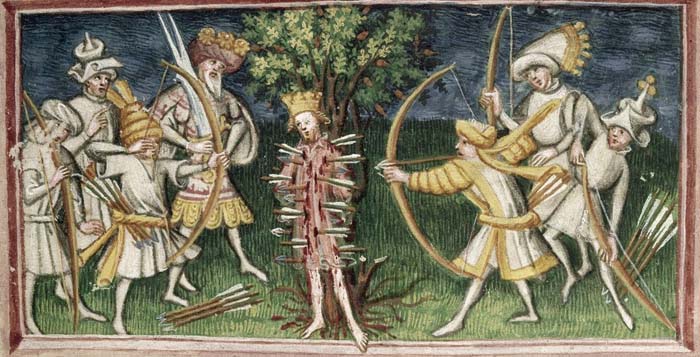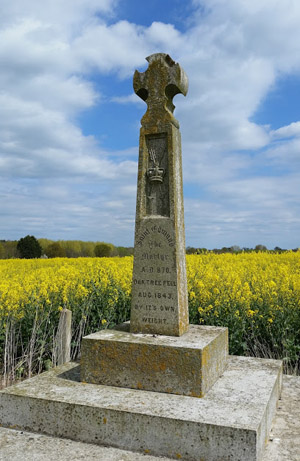St. Edmund, King and Martyr († 870; Feast – November 20)
Adapted from Fr. Alban Butler's Lives of the Saints...
 Though from the time of King Egbert, in 802, the kings of the West-Saxons were monarchs of all England,
yet several kings reigned in certain parts after that time, in some measure subordinate to them. One of these – Offa,
King of the East-Angles – who being desirous to end his days in penance and devotion at Rome,
resigned his crown to St. Edmund, at that time only fifteen years of age, but yet a most virtuous prince,
and descended from the old Anglo-Saxon kings of this isle. The Saint was placed on the throne of his ancestors,
as Lydgate, Abbo, and others express themselves, and was crowned by St. Humbert, Bishop of Elman,
on Christmas Day in 855, at Burum, a royal villa on the Stour, now called Bures. Though very young,
he was by his piety, goodness, humility, and all other virtues, the model of good princes.
He was a declared enemy of flatterers and informers, and wished to see with his own eyes and hear with his own ears,
to avoid being surprised into a wrong judgment, or imposed upon by the passions or ill designs of others.
The peace and happiness of his people were his whole concern, which he endeavored to establish by an impartial
administration of justice and religious regulations in his dominions. He was the father of his subjects,
particularly of the poor, the protector of widows and orphans, and the support of the weak.
Religion and piety were the most distinguishing part of his character.
Though from the time of King Egbert, in 802, the kings of the West-Saxons were monarchs of all England,
yet several kings reigned in certain parts after that time, in some measure subordinate to them. One of these – Offa,
King of the East-Angles – who being desirous to end his days in penance and devotion at Rome,
resigned his crown to St. Edmund, at that time only fifteen years of age, but yet a most virtuous prince,
and descended from the old Anglo-Saxon kings of this isle. The Saint was placed on the throne of his ancestors,
as Lydgate, Abbo, and others express themselves, and was crowned by St. Humbert, Bishop of Elman,
on Christmas Day in 855, at Burum, a royal villa on the Stour, now called Bures. Though very young,
he was by his piety, goodness, humility, and all other virtues, the model of good princes.
He was a declared enemy of flatterers and informers, and wished to see with his own eyes and hear with his own ears,
to avoid being surprised into a wrong judgment, or imposed upon by the passions or ill designs of others.
The peace and happiness of his people were his whole concern, which he endeavored to establish by an impartial
administration of justice and religious regulations in his dominions. He was the father of his subjects,
particularly of the poor, the protector of widows and orphans, and the support of the weak.
Religion and piety were the most distinguishing part of his character.
As books were then large, scarce, and expensive, monks and devout persons used to memorize the psalter,
that they might recite the psalms at work, while travelling, and on every other occasion. To learn it by heart,
St. Edmund lived in retirement a whole year in his royal tower at Hunstanton (which he had built for a country solitude),
now a village in Norfolk, on the North Sea. The book which the Saint used for that purpose was religiously kept at
St. Edmundsbury until the dissolution of the abbeys by Henry VIII.
The holy King Edmund had reigned fifteen years when the Danes invaded his dominions.
The Danish Chronicle relates that Regner Lodbrog, King of Denmark, was taken prisoner, and put to death in Ireland,
which he had invaded. His sons, after having subdued Norway, laid England to waste. Two of these brothers,
Hinguar and Hubba, the most barbarous of all the Danish plunderers, landing in England, wintered among the East-Angles.
Then, having made a truce with that nation, they sailed to the north in summer, and landing at the mouth of the Tweed,
plundered with fire and sword Northumberland, and afterward Mercia, directing their march through Lincolnshire,
Northamptonshire, and Cambridgeshire. Out of a lust of rage and cruelty, and the most implacable aversion to the
Christian name, they everywhere destroyed the churches and monasteries; and, as it were, in barbarous sport,
massacred all priests and religious persons whom they met with. In the great monastery of Coldingham, beyond Berwick,
the nuns fearing not death, but insults which might be offered to their chastity, at the instigation of St. Ebba,
the holy abbess, cut off their noses and upper lips, that, appearing to the barbarians frightful spectacles of horrors,
they might preserve their virtue from danger. The infidels accordingly were disconcerted at such a sight,
and spared their virtue, but put them all to the sword.
The barbarians, reeking with blood, poured down upon St. Edmund's dominions, burning Thetford,
the first town they met with, and laying waste all before them. The people, relying upon the faith of treaties,
thought themselves secure, and were unprepared. However, the good king raised what forces he could, met the infidels,
or at least a part of their army, near Thetford, and discomfited them. But seeing them soon after reinforced with
fresh numbers, against which his small army was not able to make any stand, and being unwilling to sacrifice the
lives of his soldiers in vain, and grieving for the eternal loss of the souls of his enemies, who would be slain
in a fruitless engagement, he disbanded his troops, and retired himself towards his castle of Framlingham in Suffolk.
The barbarians had sent him proposals which were inconsistent both with religion and with the
justice which he owed to his people. These the Saint rejected, being resolved rather to die a victim for his
Faith and duty to God, than to do anything against his conscience and religion. In his flight he was overtaken
and surrounded by infidels at Oxon, upon the Waveney. He concealed himself for a short time, but, being discovered,
was bound with heavy chains, and conducted to the general's tent. Terms were offered him equally prejudicial to
religion and to his people, which the holy king refused to confirm, declaring that religion was dearer to him than his life,
which he would never purchase by offending God. Hinguar, exasperated at this answer, in his barbarous rage caused him
to be cruelly beaten with cudgels, then tied to a tree and torn a long time with scourges. All this he bore with
invincible meekness and patience, never ceasing to call upon the Name of Jesus.

The infidels were the more exasperated, and as he stood bound to the tree, they made him a target
to wantonly shoot at, until his body was covered with arrows, like a porcupine. Hinguar at length,
in order to put an end to the butchery, commanded his head to be struck off. Thus the Saint finished his
martyrdom on the 20th of November, in 870, the fifteenth of his reign, and twenty-ninth of his age;
the circumstances of which St. Dunstan learned from one who was armor-bearer to the Saint, and an eye-witness.
The place was then called Henglesdun, now Hoxne; a priory of monks was afterwards built there,
which bore the name of the Martyr.
The Saint's head was carried by the infidels into a wood, and thrown into the brush;
but it was miraculously found by a pillar of light, and deposited with the body at Hoxne.
These sacred remains were very soon after conveyed to Bedricsworth, since called St. Edmundsbury.
A church of timber was erected over the place where he was interred, according to the fashion of those times.
It stood until St. Canute, to make reparation for the injuries his father Swein had done to this place
and to these relics, built and founded there, in 1020, a new most magnificent church and abbey in honor of St. Edmund.
 The unparalleled piety, humility, meekness, and other virtues of St. Edmund are admirably
set forth by many historians. This incomparable prince and holy Martyr was considered by succeeding English
kings as their special patron, and as an accomplished model of all royal virtues. Henry VI, who,
with a weak understanding of secular matters, joined an uncommon goodness of heart, made the practice of religion
the study of his whole life, and shared largely in the afflictions which are the portion of the elect,
had a singular devotion to this Saint, and enjoyed nowhere so much comfort, peace, and joy as in the retreats
which he made in the monastery of St. Edmundsbury.
The unparalleled piety, humility, meekness, and other virtues of St. Edmund are admirably
set forth by many historians. This incomparable prince and holy Martyr was considered by succeeding English
kings as their special patron, and as an accomplished model of all royal virtues. Henry VI, who,
with a weak understanding of secular matters, joined an uncommon goodness of heart, made the practice of religion
the study of his whole life, and shared largely in the afflictions which are the portion of the elect,
had a singular devotion to this Saint, and enjoyed nowhere so much comfort, peace, and joy as in the retreats
which he made in the monastery of St. Edmundsbury.
No Christian can be surprised that innocence should suffer. Prosperity is often the most grievous
judgment that God exercises upon a wicked man, who by it is permitted, in punishment of his impiety,
to blind and harden himself in his evil course, and to plunge himself deeper in iniquity.
On the other hand God, in His merciful providence, conducts second causes, so that afflictions
fall to the share of those souls whose sanctification He has particularly in view.
By tribulation a man learns perfectly to die to the world and to himself, a work which,
without its aid, even the severest self-denial and the most perfect obedience, leave imperfect.
To learn to bear crosses well is one of the most essential and most important duties of a Christian life.
St. Edmund's whole life was a preparation for martyrdom.
St. Humbert, the Bishop who crowned St. Edmund, was like him martyred at the hands of the Danes,
and about the same time; therefore his feast has been observed on the same day.
Image right: Monument at the site of St. Edmund's martyrdom. Inscription: Saint Edmund the Martyr,
A.D. 870. Oak tree fell Aug. 1843, by its own weight
(i.e., the tree to which the Saint was bound when pierced with
arrows).
Back to "In this Issue"
Back to Top
Back to Saints
NEW: Alphabetical Index
Contact us: smr@salvemariaregina.info
Visit also: www.marienfried.com


 Though from the time of King Egbert, in 802, the kings of the West-Saxons were monarchs of all England,
yet several kings reigned in certain parts after that time, in some measure subordinate to them. One of these – Offa,
King of the East-Angles – who being desirous to end his days in penance and devotion at Rome,
resigned his crown to St. Edmund, at that time only fifteen years of age, but yet a most virtuous prince,
and descended from the old Anglo-Saxon kings of this isle. The Saint was placed on the throne of his ancestors,
as Lydgate, Abbo, and others express themselves, and was crowned by St. Humbert, Bishop of Elman,
on Christmas Day in 855, at Burum, a royal villa on the Stour, now called Bures. Though very young,
he was by his piety, goodness, humility, and all other virtues, the model of good princes.
He was a declared enemy of flatterers and informers, and wished to see with his own eyes and hear with his own ears,
to avoid being surprised into a wrong judgment, or imposed upon by the passions or ill designs of others.
The peace and happiness of his people were his whole concern, which he endeavored to establish by an impartial
administration of justice and religious regulations in his dominions. He was the father of his subjects,
particularly of the poor, the protector of widows and orphans, and the support of the weak.
Religion and piety were the most distinguishing part of his character.
Though from the time of King Egbert, in 802, the kings of the West-Saxons were monarchs of all England,
yet several kings reigned in certain parts after that time, in some measure subordinate to them. One of these – Offa,
King of the East-Angles – who being desirous to end his days in penance and devotion at Rome,
resigned his crown to St. Edmund, at that time only fifteen years of age, but yet a most virtuous prince,
and descended from the old Anglo-Saxon kings of this isle. The Saint was placed on the throne of his ancestors,
as Lydgate, Abbo, and others express themselves, and was crowned by St. Humbert, Bishop of Elman,
on Christmas Day in 855, at Burum, a royal villa on the Stour, now called Bures. Though very young,
he was by his piety, goodness, humility, and all other virtues, the model of good princes.
He was a declared enemy of flatterers and informers, and wished to see with his own eyes and hear with his own ears,
to avoid being surprised into a wrong judgment, or imposed upon by the passions or ill designs of others.
The peace and happiness of his people were his whole concern, which he endeavored to establish by an impartial
administration of justice and religious regulations in his dominions. He was the father of his subjects,
particularly of the poor, the protector of widows and orphans, and the support of the weak.
Religion and piety were the most distinguishing part of his character.
 The unparalleled piety, humility, meekness, and other virtues of St. Edmund are admirably
set forth by many historians. This incomparable prince and holy Martyr was considered by succeeding English
kings as their special patron, and as an accomplished model of all royal virtues. Henry VI, who,
with a weak understanding of secular matters, joined an uncommon goodness of heart, made the practice of religion
the study of his whole life, and shared largely in the afflictions which are the portion of the elect,
had a singular devotion to this Saint, and enjoyed nowhere so much comfort, peace, and joy as in the retreats
which he made in the monastery of St. Edmundsbury.
The unparalleled piety, humility, meekness, and other virtues of St. Edmund are admirably
set forth by many historians. This incomparable prince and holy Martyr was considered by succeeding English
kings as their special patron, and as an accomplished model of all royal virtues. Henry VI, who,
with a weak understanding of secular matters, joined an uncommon goodness of heart, made the practice of religion
the study of his whole life, and shared largely in the afflictions which are the portion of the elect,
had a singular devotion to this Saint, and enjoyed nowhere so much comfort, peace, and joy as in the retreats
which he made in the monastery of St. Edmundsbury.